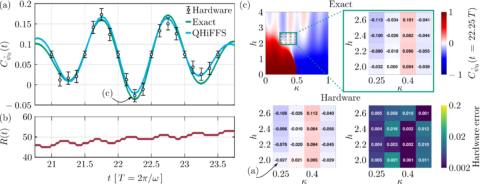Large-scale simulations of Floquet physics on near-term quantum computers
Timo Eckstein, Refik Mansuroglu, Piotr Czarnik, Jian-Xin Zhu, Michael J. Hartmann, Lukasz Cincio, Andrew T. Sornborger, Zoë Holmes
Quantum systems subject to periodic driving exhibit a diverse set of phenomena both of fundamental and technological interest. However, such dynamical systems are more challenging to simulate classically than their equilibrium counterparts. Here, we introduce the Quantum High Frequency Floquet Simulation (QHiFFS) algorithm as a method for simulating the dynamics of fast-driven Floquet systems on quantum hardware. Central to QHiFFS is the concept of a kick operator which transforms the system into a basis where the dynamics is governed by a time-independent effective Hamiltonian. This allows prior methods for time-independent Hamiltonian simulation to be lifted to the simulation of Floquet systems. We use the periodically driven biaxial next-nearest neighbor Ising (BNNNI) model as a case study to illustrate our algorithm. This oft-studied model is a natural test bed for quantum frustrated magnetism and criticality. We successfully implemented a 20-qubit simulation of the driven two-dimensional BNNNI model on Quantinuum’s trapped ion quantum computer. This is complemented with an analysis of QHiFFS algorithmic errors. Our study indicates that the algorithm exhibits not only a cubic scaling advantage in driving frequency ω but also a linear one in simulation time t compared to Trotterisation, making it an interesting avenue to push towards near-term quantum advantage.
https://arxiv.org/abs/2303.02209

